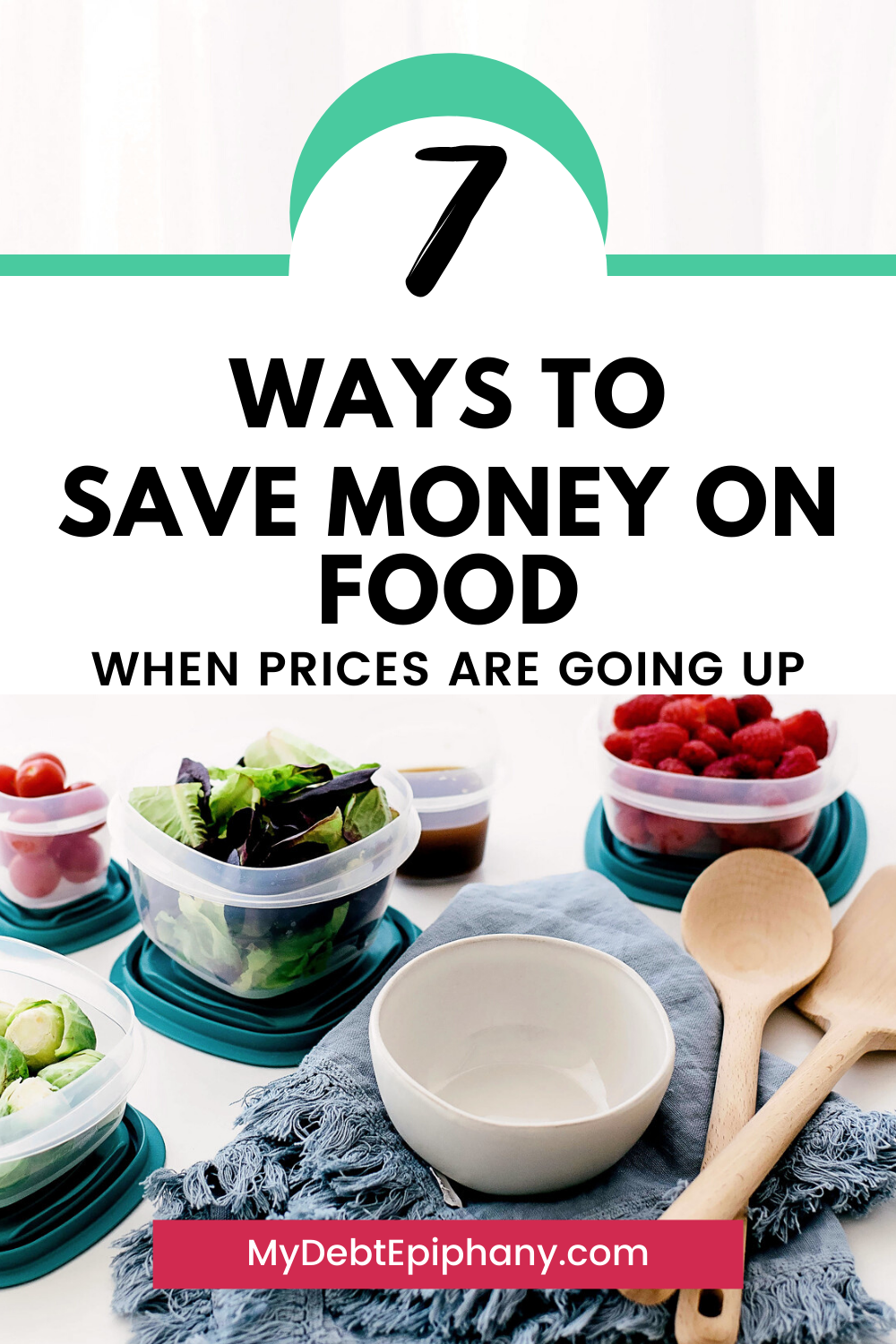How I’m Dealing With the Rising Cost of Food
Food costs can be one of the trickiest expenses to manage. It’s a fluctuating expense that can change no matter how well you budget for it. Over the past few years, I’ve been able to keep our family’s monthly grocery spend to around $300 – $350. This doesn’t include dining out.
However, lately I feel like we’ve been spending more money on food overall especially with being at home more over the past few months.
Table of Contents
Are Food Prices Going Up?
Maybe you’ve gone shopping recently and asked yourself if food prices are going up. I’ve had to do a few double takes and really ask myself if the price of milk and eggs have gone up or if the $14 organic chicken breast I just passed was always that expensive.
On Father’s Day, I went to pick up a meal for my husband at a restaurant and they had a sign in the window about price increases. According to them, the cost of beef has gone up so they’d added $2 to the cost of their meals that include beef.
According to the Wall Street Journal, food makers and supermarkets are dealing with the biggest rise in food prices since the 1970s. If your grocery bills have gone up or you find you’re spending more money on takeout, don’t beat yourself up about it.
Times are very hectic right now but there’s always a chance to regroup and establish a plan. Here are a few key things my family and I are doing right now to help us deal with the food prices rising.
Related: How to Eat Well With a $300 Monthly Grocery Budget
Continuing to Eat at Home
Eating at home is still one of the best ways to save money on food. Whatever you prepare will usually be cheaper than buying ready-made food at the grocery store from the hot bar or ordering takeout.
My family and I purpose to dine out maybe once a week and support a local business. Even then, we keep it pretty affordable. Otherwise, we prepare most of our meals at home and try to switch it up.
I keep a running document in Google Drive of our favorite meals and snacks. I’ve also been referring a cookbook for the first time ever. I have Magnolia Table Volume 2 which features some of Joanna Gaines’ favorite recipes.
I like how Joanna lists a lot of pantry staples and ingredients to always have on hand like flour, butter, sugar, etc. Most of the stuff in the book is pretty affordable to prepare so long as you have the regular pantry staples. Plus, it gives me a variety of meal ideas since my family doesn’t like eating the same thing each week.
An alternative to using a cookbook for frugal meal ideas would be to simply look up some recipes online
If meal planning and prep isn’t your forte, I’d highly recommend simplifying this aspect of your life by signing up for the $5 Meal Plan. For just $5/month you’ll get healthy and affordable recipes and shopping lists delivered to your inbox weekly. The $5 Meal Plan also has gluten-free and picky-eater-friendly recipes, plus you can try it out for free for 2 weeks. You’ll love it!
Buying in Bulk
If you shop around and compare prices, buying food in bulk from a warehouse club like Costco may be cheaper. If you know your family eats a lot of a particular food, why not try to buy it in bulk and save?
It’s important to do your research though because there are some things I will not buy from Sam’s Club or Costco because it’s just not a good deal. When you do bulk buying, I also recommend you limit your shopping trips to 1-2 times per month. Unless you have a big family, shopping too much at a warehouse club can easily cause you to overspend and buy more than you really need.
Pro Tip: When you go shopping for food get more bang for your buck by using Fetch Rewards. It’s free and you can shop anywhere then scan your receipt to receive rewards like free gift cards. This summer use the promo code: FETCH3K to automatically earn $3.00 free in your account. The app is available for both Apple and Android users.
Related: How to Save Even More Money on Groceries With Fetch Rewards
Cooking in Bulk/Eating Leftovers
If you’re buying in bulk, you can cook in bulk too. I remember one time I went to a family member’s home and they told me they never eat leftovers. To each his or her own, but we live on leftover at my house. In fact, I purposely prepare too much food so we can eat it for 2-3 nights.
I like preparing soups and stews that will last us a few days. In warm weather months, we can do pasta salad and whatever my husband decides to make on the grill. We have a charcoal grill and I always like to throw a ton of stuff on it that we can meal prep for the week to get the most use out of the charcoal.
Having a Cleanout Meal/Day
We have what I like to call ‘cleanout meals’ a few times per month. If you’re spending more money on food, you might at well plan your meals more closely and be intentional about eliminating food waste. Each week I try to rotate what’s in the fridge and move snacks and meals up so people can eat them before they go bad.
If I notice there’s a ton of random foods and leftovers in the fridge, we will have a cleanout meal. Maybe there are a few hotdogs leftover or a frozen pice of tilapia in the fridge. Sometimes, I have a few pieces or broccoli or some brown rice in the cabinet that needs to get finished off. Everyone may eat something different for lunch or dinner, but the focus will be a cleanout of what’s been left in the fridge before we go to the store and buy more stuff.
Trying Different Foods
This is one of the easiest ways to deal with rising food costs. Consider buying the food that’s on sale at the time even if you normally wouldn’t have considered it. I love trying new foods so if there’s a new vegetable or even a foreign food that’s on sale, I may do a little research but it’s definitely an option for me.
A few years ago, I found out about pierogies which is a European dumbling and their pretty cheap if you can find them frozen at the grocery store
Gardening
I started gardening two years ago when we bought our house. Luckily there was already a gardening box in the yard but it’s a little small. Right now, I’m just growing a few vegetables but plan to expand my garden next year.
Learning to grow my own fruits and vegetables has been a great experience and in the future, I hope to have a more sustainable supply which will help us cut food costs.
You don’t need a ton of supplies when you get started and you can just consider getting some seeds or even regrowing produce from the fruits and vegetables you already have. Check out this video about regrowing and how easy it can be.
You also don’t need a house to start a garden. You can start one in an apartment or anywhere else. The key is to just start with what you have and learn over time. Read books, listen to podcasts, watch videos, and get advice from people you know. Over time, you’ll get a green thumb and can enjoy the benefits of growing your own produce.
Use Coupons
I’m not the biggest fan of couponing, but I actually wanted to give it a try since it’s basically a way to get heavily discounted or free products. I tried couponing a few years ago but after watching some videos recently I realized I was doing it all wrong.
When you coupon you need to have a strategy and be efficient so you don’t waste time. I’ve started picking up the Sunday newspaper at the Dollar Tree and I have my son help me cut out coupons then we categorize them. I chose just 1-2 stores for now that I want to focus on so I can get used to their coupon policy.
From my research, I learned that successful couponers actually wait for products to go on sale and they know the sale cycles of different stores. Then they use that information to maximize savings opportunities. I’m not trying to gather a huge stockpile with couponing. I figured I’ll just spend 1-2 hours per week doing it for now and see what I can save. If you have older kids, this could be a great task for them to help with as well.

Final Thoughts
I don’t think food prices will go down any time soon. If you’re not ready to increase your grocery budget, consider trying out some of these tips to see what works best for you. Being able to provide my family with healthy and whole meals is important to me, but I don’t want to pay an arm and a leg for it.
How are you saving money despite food prices rising all over?
Stop Worrying About Money and Regain Control

Join 5,000+ others to get access to free printables to help you manage your monthly bills, reduce expenses, pay off debt, and more. Receive just two emails per month with exclusive content to help you on your journey.






